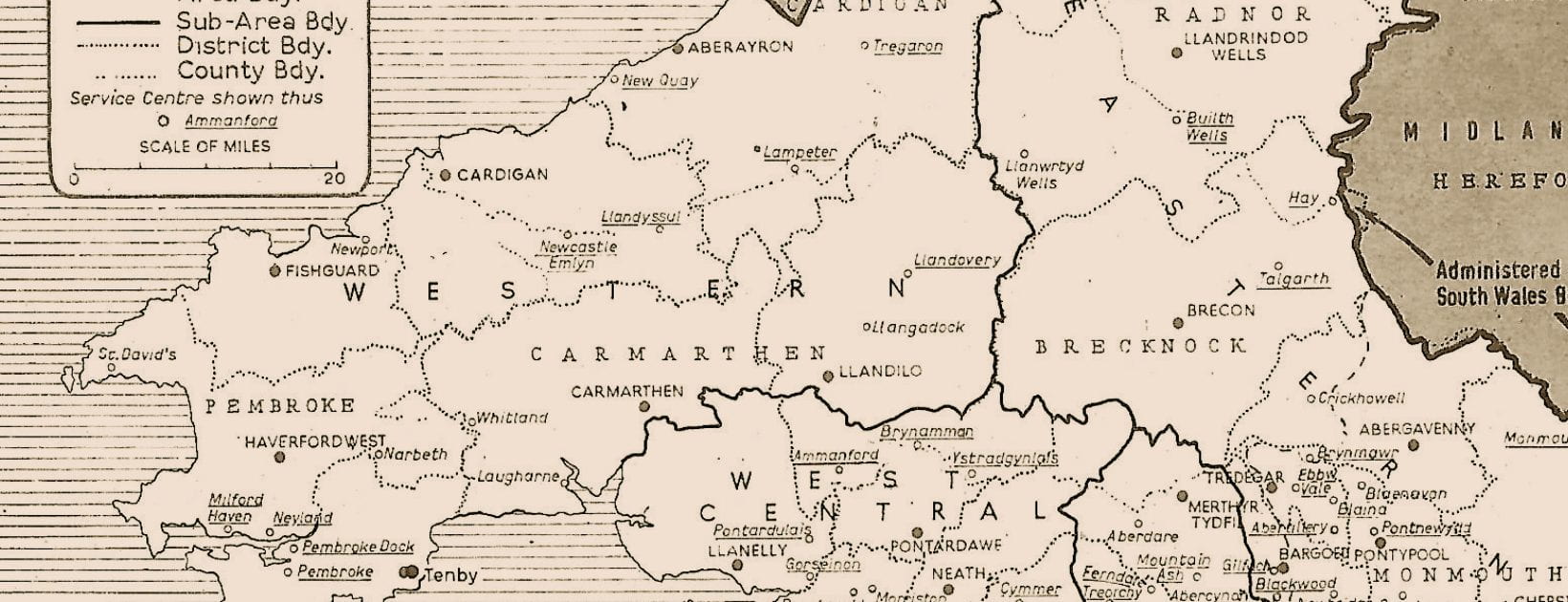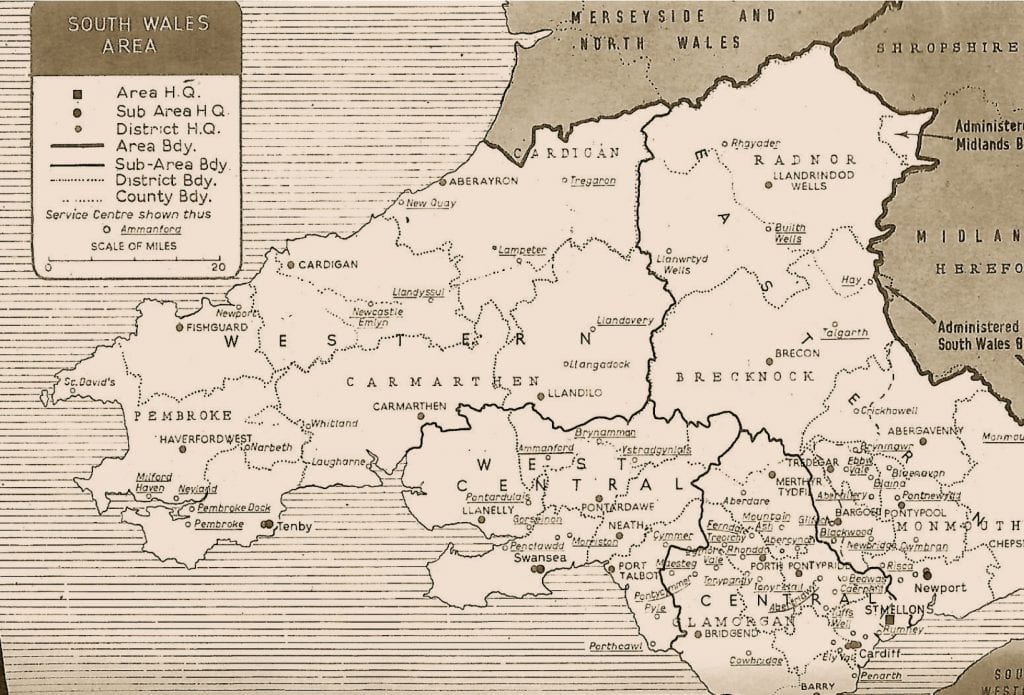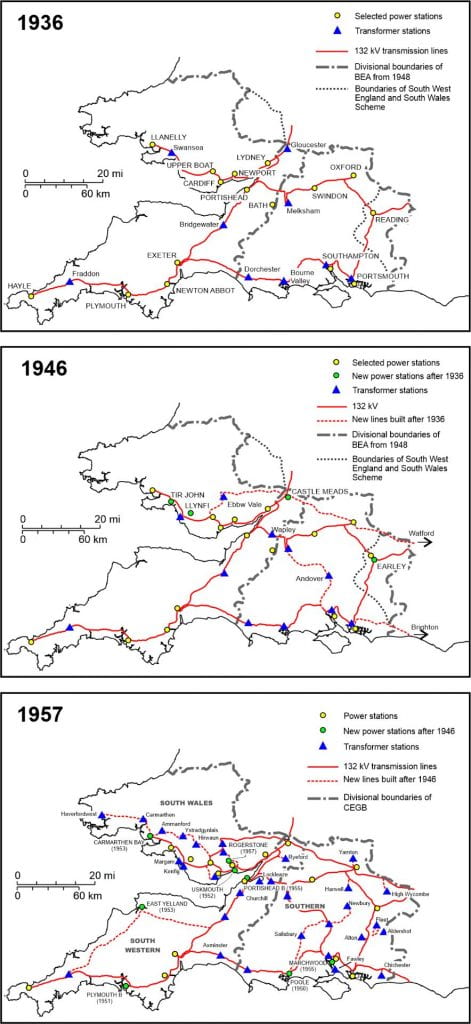After three decades of discussion the whole organisation of electricity was restructured following the Electricity Act 1947. From 1 April 1948, the South Wales Electricity Board took over the distribution assets of 31 local authorities and 13 companies (Figure 1). The generating stations and the transmission lines of the Central Electricity Board were transferred to the British Electricity Authority.
Electricity Distribution
Integrating the various undertakings was a huge task for the new Board. Systems had to be standardised and the multiplicity of tariffs reduced. For administrative purposes, the Board area was subdivided into four sub-areas and 25 districts. Initially the districts tended to reflect the pre-nationalisation company and municipal areas. Four districts were added on 1 April 1949 when the former areas of the SWS Company and West Gloucestershire Power were integrated.[32]
Figure 6 shows the geographical organisation in 1957 when some further reorganization had taken place. One notable feature was the network of 84 service centres where consumers could pay their bills and purchase appliances. These service centres were an important and profitable part of the Board’s business.
Figure 6 SOUTH WALES, 1957
The South Wales Electricity Board’s first decade of operation coincided with a major phase of growth of demand in all segments of the market. Industrial growth was very strong, electrification had been extended especially in rural areas, and new residential construction was booming, including a New Town at Cwmbran. Between 1948/9 and 1958/9 the number of consumers increased from 436,200 to 628,027 and sales grew from 2,252 to 4,863 million kWh. To serve this growth, the Board’s employees increased from 4,964 to 7,309.
Electricity Generation and Transmission
The South Wales Division of the British Electricity Authority covered the area of the South Wales Board together with the western part of Gloucestershire. It was an amalgamation of the 132kv transmission developed by the Central Electricity Board and the power stations previously owned by companies and local authorities. The main tasks from 1948 were to integrate the various generating stations and their workforces, to modernise and standardise operations, and to expand capacity to meet the rapidly growing demand.
Table 7 shows the 23 power stations in the new organisation. They varied in size from large turbine-powered stations at the top to small diesel-and hydro units at the lower end. Llynfi was a new station only five years old, while Merthyr Tydfil still used the equipment installed at its opening in 1901. A comparison with Table 4 shows that most of the growth in capacity had taken place at the larger selected stations: Cardiff, Newport, Tir John and Upper Boat.
Table 7 BRITISH ELECTRICITY AUTHORITY POWER STATIONS IN THE SOUTH WALES DIVISION 1948/49
Private generation was maintained, although the Coal Board as the new owner of the collieries power systems did not invest in any expansion of the facilities. The larger iron and steel works also continued to generate electricity for their own use.
Within a decade, most of the objectives planned in the late 1940s had been fulfilled. Two existing stations, at Llynfi and Haverfordwest, had been extended and three new stations—at Carmarthen Bay, Burry Port (1953-57), Rogerstone (1957)[33] and Uskmouth (1952-57)—had been completed. New stations at Aberthaw and Uskmouth B were under construction. These stations incorporated larger generating sets of 100/120,000kW capacity and had correspondingly larger boiler units working at a pressure of 1500lbs per square inch. Between 19948/9 and 1958/9 the number of power stations had been reduced from 23 to 13, while total generating capacity had more than doubled (Table 8).
Table 8 CENTRAL ELECTRICITY GENERATING BOARD POWER STATIONS IN THE SOUTH WALES DIVISION 1958/59
The original grid transmission system had been extended during the war (Figure 7). A new line from Watford via Oxford and Gloucester to Ebbw Vale and Upper Boat added new capacity for the heavy demands of South Wales industry. In the 1950s West Wales was connected to the grid with a transmission line from Upper Boat to Haverfordwest. Additional transformer stations were built at Carmarthen, Ammanford, Ystradgynlais and Hirwaun as well as at Trostre and Margam to supply the expanded steel works.
By the late 1950s some of the results of new expansion plans were beginning to show in the landscape. Since the existing national transmission grid was limited in capacity, especially for inter-regional transfers of power, a new Supergrid at 275kv (later raised to 400kv) was being developed. A line from Melksham to Pyle, near Port Talbot, was under construction and the tall towers for the Severn crossing at Aust and Beachley Point had been completed. New generating technology in the form of nuclear power was also being introduced. No nuclear station were built in South Wales but two stations were developed on the Severn estuary at Berkeley and Oldbury in the 1960s.[34]
During the first decade of operation the South Wales Division built three new power stations and raised generating capacity from 599,183kW to 1,474,565kW. The whole system had been integrated and modernised, with 15 old, small stations being closed. Transmission line capacity was increased from XX to 371 route miles between 1948/9 and 1958/9. Over this period the number employed rose from 2,174 to 3,366.
From January 1958, when the Central Electricity Generating Board took over from the Central Electricity Authority, there were changes in the administrative structure. A new South Western Region was established incorporating the Southern, South Western and South Wales Divisions. Under the new arrangements the regional director in Bristol became responsible for the higher-order planning and administration of 43 power stations, 1,768 miles of transmission lines and 8,979 employees. The divisional offices in Cardiff not only lost some administrative roles but design work was transferred to new project groups outside the region.
[32] South Wales Electricity Board, First Annual Report 1958-0.
[33] The Rogerstone site was a substitute from an earlier proposal at Machen on the Rhymney River where after strong objections and a public inquiry the Minister of Fuel and Power had refused consent. Electricity Report of the Minister of Fuel and Power for the year ending 31 March 1954, Parliamentary Paper HC 249, 1953-54, p.9.
[34] A site at Portskuett for a nuclear power station in the late 1960s was rejected after strong local and regional opposition.
[next]




